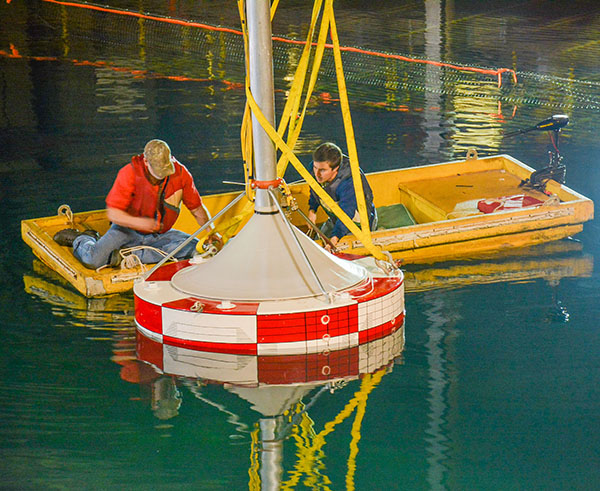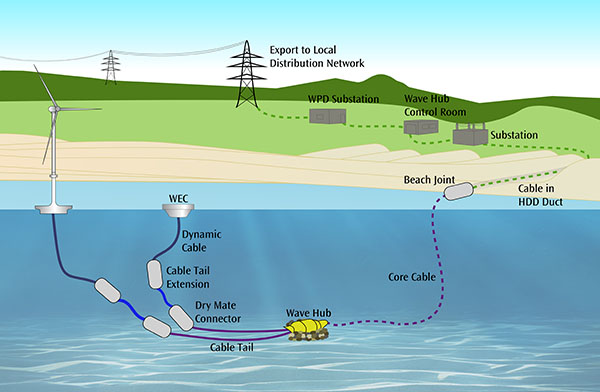Wave energy researchers dive deep to advance clean energy source
One of the biggest untapped clean energy sources on the planet — wave energy — could one day power millions of homes across the US. But more than a century after the first tests of the power of ocean waves, it is still one of the hardest energy sources to capture.

CATCH A WAVE — Sandia researchers Ryan Coe and Giorgio Bacelli (both 6122) are collecting data at the US Navy’s Maneuvering and Sea Keeping facility in Bethesda, Maryland, to optimize wave energy converter testing.
Now, engineers at Sandia are conducting the largest model-scale wave energy testing of its kind to improve the performance of wave-energy converters (WECs). The project is taking place at the US Navy’s Maneuvering and Sea Keeping facility at the Carderock Division in Bethesda, Maryland, one of the largest wave tanks in the world at 360 feet long and 240 feet wide and able to hold 12 million gallons of water.
Sandia project leads Ryan Coe and Giorgio Bacelli (both 6122) spend long days in the dark wave tank, where minimal lighting reduces the growth of algae in the water. They are collecting data from their numerical modeling and experimental research to benefit wave energy technology with improved methodologies, strategic control systems design, and testing practices for wave energy converters.
Tackling challenges of harsh environments
“Our goal is to improve the economic viability of these devices,” says Ryan. “To do so, we are working out ways to control the WEC’s generator to increase the amount of power it absorbs. At the same time, we are looking at how to reduce the loads and stresses on these devices in harsh conditions to ultimately lengthen a WEC’s lifespan in the water.”
Ryan says numerous initial studies estimate that improving control of the WECs’ generators can dramatically increase energy absorption by as much as 300 percent. Transitioning these simplified studies to more realistic large-scale devices is the challenge at hand.
To control the dynamics for better, faster results in the wave tank, Ryan and Giorgio are using modeling and control methods that have been successful in other industries, such as in the aerospace industry.
More informaton in a fraction of the time
“The systems we used have been around for a while, but strangely enough they had never been applied to wave energy converters,” Giorgio says. “So far, we know the techniques we are using are more efficient and cost-effective than existing methods. We are getting more information in a fraction of the time.”
Now that Sandia has completed the first round of analyses in the water, Ryan says the goal is to process all the collected data to develop a new, enhanced model that will make sure the next test yields even more valuable results.
“Make no mistake, these are extremely complex machines,” Giorgio says. “They have to be fine-tuned continuously because ocean waves are constantly changing. With this setup at the Navy’s facility, we have a unique opportunity to study the problems and quantify the effects. We want to help the industry by offering solutions to the challenges the wave energy world is facing.”
Sandia’s continuing wave energy project, Advanced WEC Dynamics and Controls, kicked off in 2013 and is funded by DOE’s Office of Energy Efficiency and Renewable Energy.
Innovations from Sandia’s Water Power Technologies Program advance the nation’s energy security by making renewable energy more economically feasible, says Ryan. Contributions include WEC-Sim, an open source code for modelling the performance of wave energy converters, extreme-conditions modeling, and tidal and turbine modeling. Sandia researchers serve as advisers and judges for DOE’s Wave Energy Prize competition.
The Advanced WEC Dynamics and Controls project team includes Sandia researchers David Wilson (1353), Kevin Dullea (6533), Mark Monda (6532), Steve Spencer (6533), Clint Hobart (6532), Anirban Mazumdar (6533), David Patterson (6122), Mike Salazar (6012) and Tim Crawford (6122).

As the waves move it up and down, a wave energy converter can generate clean and renewable energy. The power from the device is transmitted to shore via an undersea cable for the US electrical grid. Click to download a hi-rez image.